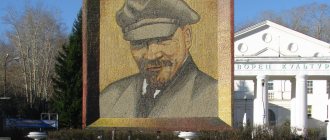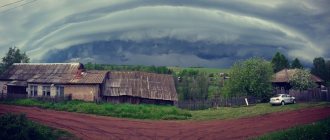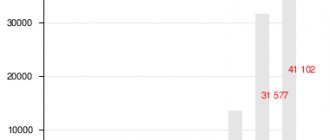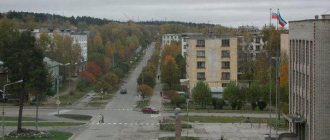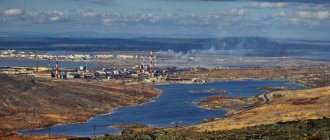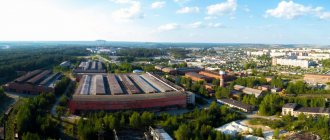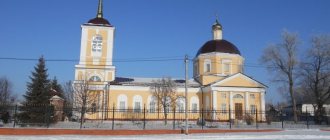The city of Plast is located at the source of the Kochkarka River, a right tributary of the Kabanka River. It was founded as the Kochkarsky mine on a deposit of gold sands around 1860. The name of the city comes from the geological feature of the area - a sheet-like deposit of gold-bearing sands.
By 1845, several mines were already operating here: Averyanovsky, Voskresensky, Novotroitsky, Uspensky and others. Some of the mines were developed by foreigners from England, the “Anonymous Society of Kochkar Mines” from France). Mining villages grew over time and gradually merged into one settlement. In 1931, the village of Plast was formed, which received city status in 1940. Previously, Plast was part of the Kochkarsky district, then it became the center of the Plastovsky district of the Chelyabinsk region.
Gold mining here is still carried out today by the Yuzhuralzoloto enterprise. Gold mining forms the basis of the city's economy. By the way, the subsoil in the vicinity of Plast is rich not only in gold, but also in gems. It’s not for nothing that this area is called “Russian Brazil”.
Interesting fact: in 1989, a mineral called kochkarite was found for the first time in the world at the Kochkar gold deposit in the city of Plast.
The population of Plast, according to the 2010 census, is 17.5 thousand people.
Sights of Plast
Plast is quite an interesting and pleasant city. When traveling around the Southern Urals, it’s definitely worth setting aside some time and stopping by here.
In the park on Krasnoarmeyskaya street opposite the cinema named after A.S. Pushkin there is a monument to the prospector , which, according to the creators, immortalized the history of the creation and name of the city. It is dedicated to the discoverers of the Kochkar gold deposit, the first prospectors and geologists. The monument was opened in 2014. Its authors are sculptors A.V. Ryabov and K.A. Gelev. Alexander Ryabov created the image of the prospector from old photographs. I made the monument.
I note that the monument turned out to be very expressive. It depicts an older man in working clothes of the time, who sits on the ground and hopefully washes sand in a tray in search of gold. The height of the cast iron monument reaches 3 meters.
Krasnoarmeyskaya Street smoothly turns into Oktyabrskaya - the main street of the city.
On the main square there is the city administration, the Oktyabr Palace of Culture, and a children's art school. There is also a memorial dedicated to Plastov residents who died during the Great Patriotic War.
Nearby is the picturesque entrance gate to the city park . They contain Soviet symbols.
In the park there are monuments to Peter and Fevronia, a Komsomol stele, a Border Pillar, a memorial sign of the Airborne Forces, and a monument to a teacher.
On the other side of the park is the most interesting architectural landmark of the city - the wooden building of the dacha of gold miner A.P. Balasa , built in 1911 in Art Nouveau style. It combines elements of Gothic and Russian merchant style. The Balas mansion has the status of an architectural and historical monument of regional significance.
Currently, the building houses the Plastovsky Museum of History and Local Lore (Oktyabrskaya St., 56, tel. (35160) 2-12-92). The museum is very interesting. It has 17 exhibition halls: mineralogy, the history of gold mining, archeology, a hall of industrial enterprises, 2 military halls, 2 exhibition halls, a demonstration gallery, etc. The office of gold miner A.P. was also recreated. Balasa, furniture and belongings of his family have been preserved here. The museum's holdings include more than 18 thousand items.
In the park in front of the museum there is a monument to the dead miners . It was opened in 2011. The names of the deceased miners (since 1878) are engraved on the granite pedestal. There are 275 names in total. The mines that operated here are also listed.
St. Nicholas Church in Plast (Chekhova St., 9) is unusual in that it was built in Soviet times - in 1947-48. Rare case! Before the revolution, three churches operated on the territory of modern Plast. In the 1930s, they were all closed: one building was demolished, another was given over to a gold shop and a tea shop (the building later burned down), and school No. 1 was opened in the third.
a mosque in the city (Lenina St., 13), the only one in the Plastovsky district. It was built by Muslims at the expense of gold miner Yegor Mitrofanovich Simonov at the turn of the 19th and 20th centuries.
In the surrounding area it is worth seeing the village of Kochkar, Demarinsky waterfall, Peipus mine, Andreevsky stone quarry, Leninsky hill.
I suggest watching a video we filmed during a trip around the Chelyabinsk region, during which we also visited the city of Plast.
Notes
- ↑ 12
www.gks.ru/free_doc/doc_2016/bul_dr/mun_obr2016.rar Population of the Russian Federation by municipalities as of January 1, 2016 - ↑ 12345678910
www.MojGorod.ru/cheljab_obl/plast/index.html People's encyclopedia “My City”. Plast (city) regional significance Asha | Kartaly | Kasli | Katav-Ivanovsk | Ozyorsk | Satka | Snezhinsk | Trekhgorny regional significance Bakal | Verkhneuralsk | Kusa | Minyar | Nyazepetrovsk | Sim | Yuryuzan
How to get to the city of Plast?
From Chelyabinsk you need to follow the highway to Troitsk, in Yuzhnouralsk turn to Magnitogorsk, and then at the junction follow the sign for Plast. Distance from Chelyabinsk – 120 km, from Ekaterinburg – 330 km. You can also get there by regular buses from Chelyabinsk.
Pavel Raspopov
Sources: Sights of the Plastovsky district Map74.rf Rundqvist N., Zadorina O. Ural. Illustrated encyclopedia of local history Chelyabinsk region. Guide. – Ekaterinburg: Fest Hand, 2016. Encyclopedia of the Chelyabinsk region
History of "Russian Brazil"
“Russian Brazil” is located mainly along the Kamenka and Sanarka rivers. These places have interested people since ancient times. Russian settlers who came here in the 18th century came across ancient burial grounds - “Chudskie mines”. Since the 1760s, copper, silver, and lead were mined at the first mines - Sanarsky and Krestovozdvizhensky. In 1770, P.S. visited the Sanarsky mine. Pallas, who left his first description. From his works it follows that “ancient ovens” already stood here before.
In 1844, workers while breaking limestone to burn it into lime accidentally stumbled upon gold. The merchant Bakakin from the city of Troitsk applied for the extraction of the precious metal, and the Kamenno-Pavlovsky mine arose. Soon other mines appeared, they began to be called Kochkarsky and Andree-Yulevsky. There was a lot of gold here. In 1845, 2 kg 463 g of gold were mined, and in 1850 - already 264.5 kg. Since the beginning of mining in the 19th century, the placers of “Russian Brazil” have given people about 15 tons of gold.
Experts believe that gold was mined here in past millennia. For example, items made from Kochkar gold were found in Sarmatian burial mounds near the village of Kichigino. Perhaps this is where the famous Scythian gold originates.
Finds from the Kichiginsky mounds. Historical Museum of the Southern Urals
And near the village of Stary Kumlyak, Plastovsky district, they found an unusual bronze figurine of a shaman, about 20 cm in size, apparently smelted from local metal. It is interesting because of the inconsistency in the arrangement of parts of the human body, as if they were specially moved to different places. The limbs are twisted, the head is upside down. Cosmonaut Georgy Grechko decided that the ancient metallurgists depicted an alien... The figurine dates back to the 5th-3rd centuries BC.
Bronze shaman from the outskirts of the village of Stary Kumlyak. Historical Museum of the Southern Urals
In the 19th century, when mining gold, gems were also found here, but industrialists did not pay much attention to them, concentrating on the “yellow metal.” In 1854, information about the finds of gems in local mines reached the capital. At that time, the mineralogy of these places was best studied by Academician N.I. Koksharov, who wrote “Materials on the mineralogy of Russia.” He described the finds of the first pink topaz and euclase. In 1858, Koksharov received from an Ekaterinburg merchant a whole box of minerals from the gold-bearing placers of the merchant Bakakin.
After such lines from Academician Koksharov, the glory of “Russian Brazil” was assigned to these places.
Several decades later, as Koksharov predicted, diamonds were actually found here. In 1892, the first diamond crystal was produced by gold miner A.P. Pribylev purchased it from a prospector who found a precious stone at the Viktorovsky mine. In 1893, academician P.V. Eremeev presented this diamond to Emperor Alexander III. Later, several more crystals were found, but there were very few diamonds in these places, unlike other valuable minerals
In Soviet times, one of the main researchers of “Russian Brazil” was Professor A.P. Smolin. In this territory, new previously unknown minerals kochkarite and sanarskite were discovered, which received local names, as well as a number of others.
Map
| Plast: cards |
Plast: photo from space (Google Maps) Plast: photo from space (Microsoft Virtual Earth)
| Plast. Nearest cities. Distances in km. on the map (in brackets along roads) + direction. Using the hyperlink in the distance , you can get the route (information courtesy of the AutoTransInfo website) | |||
| 1 | Yuzhnouralsk | 29 (33) | IN |
| 2 | Uvelsky | 36 (38) | IN |
| 3 | Krasnogorsky | 37 (57) | NE |
| 4 | Yemanzhelinsk | 53 (71) | NE |
| 5 | Zauralsky | 53 (83) | NE |
| 6 | Uyskoye | 53 (97) | Z |
| 7 | Troitsk | 58 (86) | SE |
| 8 | Pervomaisky | 59 () | NE |
| 9 | Chesma | 62 (97) | YU |
| 10 | Korkino | 68 (90) | NE |
| 11 | Etkul | 70 (98) | NE |
| 12 | Rose | 72 () | NE |
| 13 | Chebarkul | 74 (115) | NW |
| 14 | Poletaevo | 77 () | WITH |
| 15 | Miass | 88 (95) | NW |
| 16 | Uchaly (Republic of Bashkortostan) | 89 () | IN |
| 17 | Uchaly | 93 (202) | Z |
| 18 | Chelyabinsk | 94 (122) | NE |
| 19 | Kopeisk | 96 (137) | NE |
| 20 | Mezozerny | 97 (191) | Z |
| 21 | Roschino | 108 () | WITH |
| 22 | Varna | 109 (159) | YU |
| 23 | Dolgoderevenskoe | 114 (142) | WITH |
| 24 | Zlatoust | 115 (123) | NW |
| 25 | Ferchampenoise | 115 (181) | SW |
| 26 | Verkhneuralsk | 117 (194) | SW |
a brief description of
Located on the eastern slope of the Urals, 38 km from the railway. Nizhneuralskaya station, 127 km southwest of Chelyabinsk.
Territory (sq. km): 267
Historical sketch
In the middle of the 19th century. A mine was founded at a thick layer-like deposit of gold-bearing sands, known as the Big Seam.
PGT Plast since 02/25/1929. City since 10/07/1940, formed by the union of the working settlements of Plast (grew up on the basis of the former Kachkar mine), Novotroitsk (PGT since 1938, 7.0 thousand inhabitants, 1939), Pchelnik, Vyselok, Aul and etc.
Economy
Plast is the center of the Kachkar gold mining region (gold mining has been going on since the 1860s). Yuzhnouralsk Gold Mining Production Association, Kachkanar Mining and Metallurgical Plant.
Near Plast there are deposits of marble, deposits of kaolin and talc.
Main enterprises
GLASS AND PORCELAIN AND FAIENCE INDUSTRY
CJSC industrial and commercial company “Plast-Rifey” Offers:
| Population by year (thousands of inhabitants) | |||||||
| 1931 | 9.9 | 1996 | 18.8 | 2008 | 17.4 | 2017 | 17.6 |
| 1939 | 24.1 | 1998 | 18.6 | 2010 | 17.5 | 2018 | 17.5 |
| 1959 | 25.9 | 2000 | 18.6 | 2011 | 17.3 | 2019 | 17.3 |
| 1967 | 25 | 2001 | 18.6 | 2012 | 17.2 | 2020 | 17.3 |
| 1970 | 22.7 | 2003 | 17.4 | 2013 | 17.2 | 2021 | 17.1 |
| 1979 | 19.3 | 2005 | 17.2 | 2014 | 17.3 | ||
| 1989 | 18.9 | 2006 | 17.3 | 2015 | 17.5 | ||
| 1992 | 19 | 2007 | 17.3 | 2016 | 17.5 |
Notes[ | code]
- ↑. Access date: October 17, 2022.
- Vesnovsky V.A.
Illustrated guide to the Urals. - 1st. - Ekaterinburg: Printing house “Ural Life”, 1904. - P. 358. - 442 p. - Pavel Raspopov.
.
Urals specialist
. Access date: January 16, 2022. - ↑
- . Demoscope Weekly. Access date: September 25, 2013.
- . Demoscope Weekly. Access date: September 25, 2013.
- . Demoscope Weekly. Access date: September 25, 2013.
- .
- .
- . Access date: April 8, 2016.
- . Access date: January 2, 2014.
- . Chelyabinskstat. Access date: February 13, 2014.
- . Access date: April 12, 2014.
- . Access date: May 31, 2014.
- . Access date: November 16, 2013.
- . Date accessed: August 2, 2014.
- . Date accessed: August 6, 2015.
- (October 5, 2018). Access date: May 15, 2022.
- (July 31, 2017). Access date: July 31, 2022.
- . Access date: July 25, 2022.
- . Access date: July 31, 2022.
- taking into account the cities of Crimea
- (RAR archive (1.0 MB)). Federal State Statistics Service
.
Gems of “Russian Brazil”
Although industrialists here were mainly interested only in gold, the area turned out to be rich in various precious and semi-precious stones. Aquamarines, pink and golden topaz, rubies, tourmalines, spinel, euclase and many others were found here. A.E. Fersman mentioned random finds of bucket-sized nests of aquamarine crystals. N.P. Barbot de Marny in 1855 also wrote about the discovery of an emerald on the left bank of the Kamenka River, although of poor quality.
The most famous are pink topazes. The first crystals were found at the Proroko-Ilyinsky mine in 1853 during gold panning. Mining engineer P.E. Akhmatov handed them over to the above-mentioned academician N.I. Koksharov, who noticed the similarity with the Brazilian ones and even thought then whether he was being played:
According to A.E. Fersman, 10-15 thousand crystals of colored topaz have been mined at the Kamenno-Pavlovsky and Vasilyevsky mines since 1853. And in total, about 100 kg of gold was extracted during gold mining.
Pink topazes were mined at the Zhukovskaya mine near the bed of the Kamenka River. This is a relatively small excavation (20x50 m) up to 3 m deep. Here you can find pink topaz crystals up to 5 cm long and 1-7 mm thick. Along with topaz, crystals of rock crystal, kyanite, as well as kupfferite and euclase are sometimes found in the mine. The Zhukovskaya mine is a geological and geomorphological natural monument of the Chelyabinsk region.
In 1938, the Svetlinsky deposit of piezo-optical quartz was discovered, which contributed to the victory in the Great Patriotic War. Piezoquartz was supplied to the defense industry. Since 1943, it has been one of the most important such deposits in the country.
In 1967, a unique and record-breaking find for the Urals was made here. Two giant rock crystals weighing more than 6 tons were discovered in a quartz vein.
Record rock crystal crystal Yubileiny-2. Climbing out of the pit. 1967 From the book by S.V. Kolisnichenko and V.A. Popov "Russian Brazil" in the Southern Urals"
In the Svetlinsky pegmatite quarry near the village of Svetly, aquamarines, roasterites, green tourmalines, and morions were found. Many other deposits are also known. Their descriptions can be found in the book by S.V. Kolisnichenko and V.A. Popov “Russian Brazil” in the Southern Urals.”
Reason four: Brazilian gems
Article on the topic
Samarskite for Curie. Who are the new minerals named after?
In addition to gold, the Plastov land also stores many riches, including rare euclase stones and pink topazes. The latter allowed Academician N. Koksharov to call these places “Russian Brazil”, because previously such jewelry was found only in the mines of an overseas country.
Now the rich subsoil attracts many mineral lovers to the Plastovsky district. People usually come in small groups with an experienced guide to add to their private or scientific collections. In the future, they plan to make “geological tourism” widespread - isn’t it exciting to find something valuable in a pile of ordinary stones?
Trud Stadium [edit]
Trud Stadium is the central place where city residents go in for sports. The stadium has a football field, basketball court, gym, children's playground, ice skating rink and stands. All sporting events take place here in front of people. One of the most popular activities here is football, so many teams come from surrounding villages to compete for the cup. There is also a stage on which Nikolai Baskov performed on City Day in 2019. Thanks to this place, residents lead a healthy lifestyle.
"Russian Brazil" today
Now almost all gold deposits here have been mined. Only in a few areas of “Russian Brazil” does mining of the precious metal continue. Gradually, “Russian Brazil” turned out to be undeservedly forgotten; it faded against the background of the riches of the Ilmen Mountains. But more than 200 different minerals are found here.
Geologist S.V. is involved in popularizing these places. Kolisnichenko. Minerals of “Russian Brazil” can be seen in the geological collections of many museums in the country. Nowadays, “Russian Brazil” attracts mineral lovers and collectors. True, not everyone is lucky here. Finding a gem is not so easy. Well, it’s worth remembering that any (including amateur) mining of gems without a license is prohibited under Russian law and is punishable by huge fines and even prison terms...
Reason two: a house with a frozen clock
The Plastovsky Museum of Local Lore is located in one of the oldest buildings in the city - the 106-year-old Balas House. The mansion, which belonged to a French mining engineer, is decorated with spiers and a clock that always shows the same time - the dial is not real, but decorative. Inside, guests will be shown everything that the region is famous for - minerals and gold bars that you can touch, dishes made of white kaolin clay, figures of animals living in the local forests. A separate room is dedicated to miners: visitors can view models of mechanisms surrounded by things that belonged to the workers.
Balas's house, with its turret and spiers, resembles a castle, only not made of stone, but of wood. Photo: AiF/ Photo by Evgeny Talypov
In a separate small room on the second floor, reached by a steep staircase, the office of the owner of the house, Antoine Balas, has been restored. Very little is known about Anton Petrovich himself, as he was called in Russian, and since 1917, traces of his family have been completely lost. The Frenchman is reminiscent of an impressive table, a photograph and a piano on which his wife Margarita played.
A significant part of the museum's exhibition is dedicated to miners. Photo: AiF/ Photo by Evgeny Talypov
During Soviet times, the mansion housed a police station, and it was this fact, according to museum workers, that made it possible to preserve the building almost in its original form. Now employees are making plans for the development of exhibitions and are waiting for guests - they have something to show.

